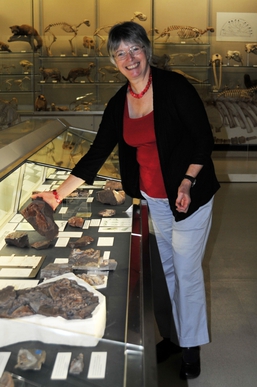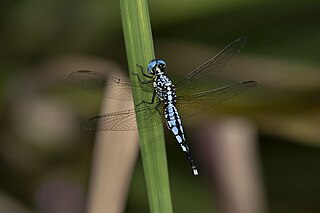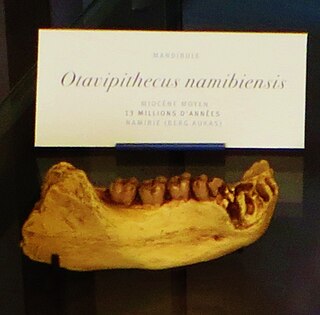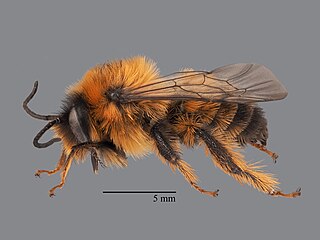
Jennifer Alice Clack, was an English palaeontologist and evolutionary biologist. She specialised in the early evolution of tetrapods, specifically studying the "fish to tetrapod" transition: the origin, evolutionary development and radiation of early tetrapods and their relatives among the lobe-finned fishes. She is best known for her book Gaining Ground: the Origin and Early Evolution of Tetrapods, published in 2002 and written with the layperson in mind.
Paleoanthropology or paleo-anthropology is a branch of paleontology and anthropology which seeks to understand the early development of anatomically modern humans, a process known as hominization, through the reconstruction of evolutionary kinship lines within the family Hominidae, working from biological evidence and cultural evidence.

Xenoturbella is a genus of very simple bilaterians up to a few centimeters long. It contains a small number of marine benthic worm-like species.

Acoela, or the acoels, is an order of small and simple invertebrates in the subphylum Acoelomorpha of phylum Xenacoelomorpha, a deep branching bilaterian group of animals, which resemble flatworms. Historically they were treated as an order of turbellarian flatworms.
Andreolepis is an extinct genus of prehistoric fish, which lived around 420 million years ago. It was described by Walter Gross in 1968 based on scales found in the Hemse Formation in Gotland, Sweden. It is placed in the monogeneric family Andreolepididae and is generally regarded as a primitive member of the class Actinopterygii based on its ganoid scale structure; however some new research regards it as a stem group of osteichthyans.

Acisoma attenboroughi, or Attenborough's pintail, is a species of dragonfly. It is a member of the genus Acisoma and was named after the naturalist Sir David Attenborough in honour of his 90th Birthday.
Warratyi is the site of a rock shelter in the Flinders Ranges in South Australia. Located around 550 kilometres (340 mi) north of Adelaide and about 200 kilometres (120 mi) inland, it has been identified as the oldest known site of human habitation in inland Australia. Newspapers reported that this rock shelter was discovered by chance in 2011 by a local resident who stumbled upon it while looking for somewhere to go to the toilet. Researchers found thousands of artefacts and bone fragments, which enabled them to date the shelter's occupation to a number of periods between 49,000 and 10,000 years ago. The finds include the earliest evidence in Australia of the development of bone and stone-axe technology, the use of ochre, and interaction with megafauna such as Diprotodon.

Marleyimyia is a genus of bee fly. It was named by Albert John Hesse in 1956; the name is in honor of Harold Walter Bell-Marley. As of 2015 it consists of three species:

Xenoturbella japonica is a marine benthic worm-like species that belongs to the genus Xenoturbella. It has been discovered in western Pacific Ocean by a group of Japanese scientists from the University of Tsukuba. The species was described in 2017 in a study published in the journal BMC Evolutionary Biology, and amended in 2018.

Xenoturbella bocki is a marine benthic worm-like species from the genus Xenoturbella. It is found in saltwater sea floor habitats off the coast of Europe, predominantly Sweden. It was the first species in the genus discovered. Initially it was collected by Swedish zoologist Sixten Bock in 1915, and described in 1949 by Swedish zoologist Einar Westblad. The unusual digestive structure of this species, in which a single opening is used to eat food and excrete waste, has led to considerable study and controversy as to its classification. It is a bottom-dwelling, burrowing carnivore that eats mollusks.

Otavipithecus namibiensis is an extinct species of ape from the Miocene of Namibia. The fossils were discovered at the Berg Aukas mines in the foothills of the Otavi mountains, hence the generic name. The species was described in 1992 by Glenn Conroy and colleagues, and was at the time the only non-hominin fossil ape known from southern Africa. The scientists noted that the surrounding area of the discovered specimen included fauna dated at "about 13 ± 1 Myr". The fossils consist of part of the lower jawbone with molars, a partial frontal bone, a heavily damaged ulna, one vertebra and a partial finger bone.

Xenoturbella churro is a marine, benthic, deep-water worm-like species that belongs to the genus Xenoturbella. It was discovered in eastern Pacific Ocean by a group of Californian and Australian scientists. The species was described in 2016 from a single specimen.

Xenoturbella profunda, the purple sock or sock worm, is a marine, benthic, deep-water worm-like species that belongs to the genus Xenoturbella. It was discovered in eastern Pacific Ocean by a group of Californian and Australian scientists. The species was described in 2016 from seven specimens.

Xenoturbella monstrosa, a deep-sea giant purple sock worm, is a marine, benthic, deep-water worm-like species that belongs to the genus Xenoturbella. It was discovered in eastern Pacific Ocean by a group of Californian and Australian scientists. The species was described in 2016 from several specimens.

Xenoturbella hollandorum is a marine, benthic worm-like species that belongs to the genus Xenoturbella. It was discovered in eastern Pacific Ocean by a group of Californian and Australian scientists. The species was described in 2016.
Mbiresaurus is an extinct genus of basal sauropodomorph dinosaur from the Late Triassic (Carnian) Pebbly Arkose Formation of Zimbabwe. The genus contains a single species, Mbiresaurus raathi, known from a nearly complete skeleton. Mbiresaurus represents one of Africa’s earliest known definitive dinosaurs.

A microbiome-wide association study (MWAS), otherwise known as a metagenome-wide association study (MGWAS), is a statistical methodology used to examine the full metagenome of a defined microbiome in various organisms to determine if some feature of the microbiome is associated with a host trait. MWAS has been adopted by the field of metagenomics from the widely used genome-wide association study (GWAS).

Dasypoda radchenkoi, also known as Radchenko's pantaloon bee, is a species of solitary bee from the family Melittidae. It was described in 2023 in the scientific journal Osmia based on specimens caught in the limestone areas of southern Spain.









